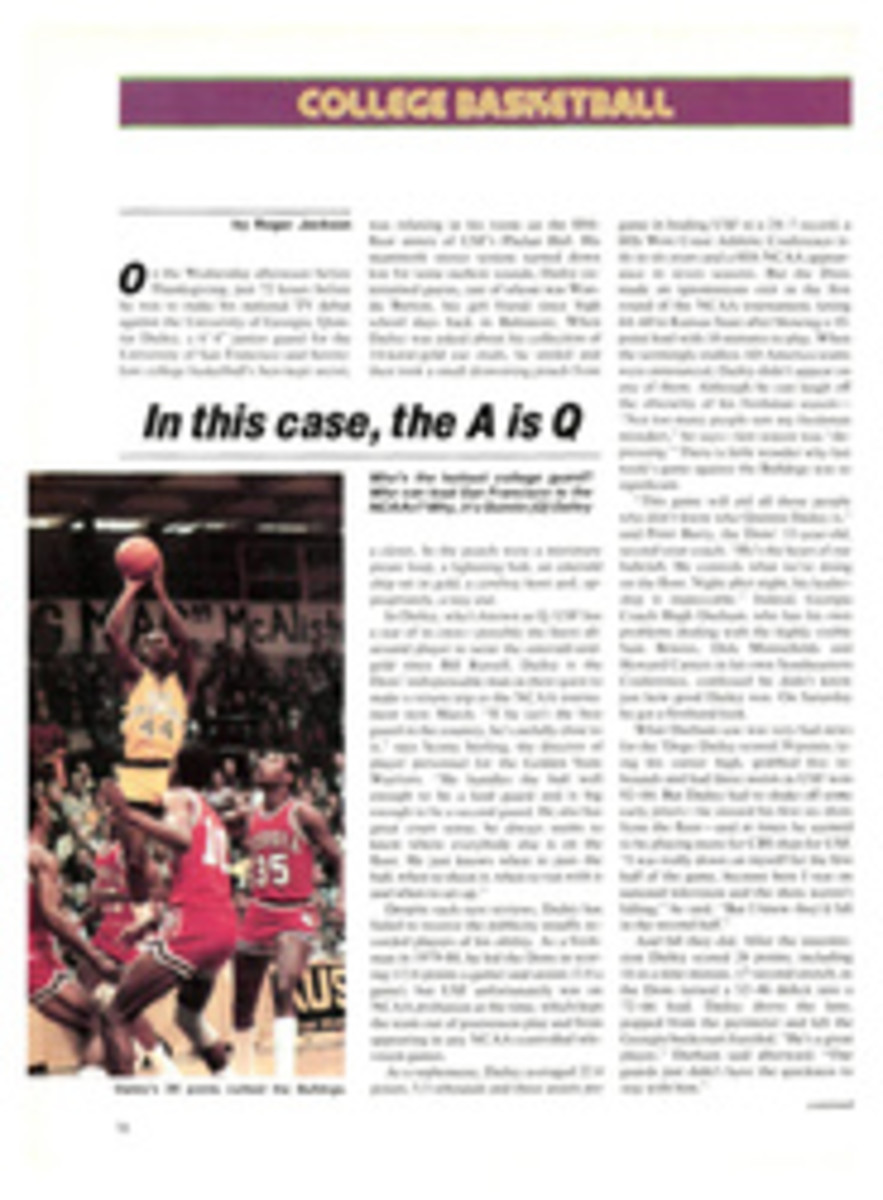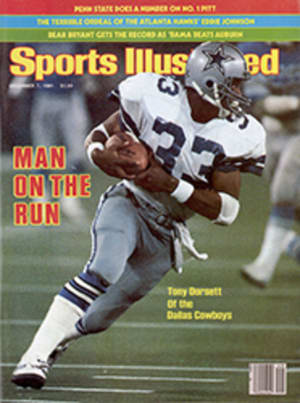
The battle went to Royle
Race officials introduced a new way of starting the 300 men contesting The Athletic Congress Cross-Country Championships in the hills above Burbank, Calif., last Saturday. There were no commands of "take your marks" or "get set," just a countdown that ended 15 seconds before the 10,000-meter race was to begin. Then an eerie silence while the poised ranks waited. The only sound was a faint encouraging shout from some runner's friend stationed far across the reaches of the carefully tended De Bell Golf Course. Then, with startling force, the gun's report.
And the charge. The field had only 500 yards of uphill turf before funneling onto a rocky road and down a steeply descending fairway. Quickly the more excitable milers were well up, with Steve Lacy in the lead. As the pack pressed together, many were sealed in. "I just got swallowed," said Steve Scott. "There was a lot of kicking and biting there among the anxious." Alberto Salazar ran patiently behind and waited. Kenya's Henry Rono improved his position by jumping onto a wall of sandbags parallel with the road and bounding past flagging early starters like an ungainly black bird. England's Nick Rose worked his way up with sharp bursts as openings presented themselves.
These were the great names from recent U.S. cross-country championships. Among them, Salazar, Rono and Rose had won seven TAC or NCAA titles, and Rose had won the English championship as well. Now after a mile, as they drew near the front of the pack, it seemed this might be their most memorable meeting. Salazar was well recovered from his world-record 2:08.13 marathon in New York five weeks before. Rono had finished his European season with a world-record 13:06.20 for 5,000 meters. Rose pronounced himself splendidly fit, saying, "It will be a great race if the others are really ready."
The setting was appropriate for an epic struggle. In the past, California cross-country has too often been run in killing sun over clay trails or smoothly rolled lawns. But De Bell is carved out of a canyon, its fairways green fingers reaching back into the dry, fire-blackened Verdugo foothills. The runners had to lift themselves 320 feet in a wearying two-mile section, and practically none of the course was level, save for the last 160 yards. Two days of steady rain had made the earth a sponge, and a dozen earlier age-group races turned the corners to soupy mud. It wasn't the plowed fields, barnyards and fences of European cross-country, but it was close.
That served the women well, because their 5,000-meter race would qualify a six-member team for the world championships next March 21 in Warsaw. (The men will hold their selection race early next year.) Knowing that early bravery would be rewarded only to the point of its causing hypoxia, a wonderfully deep field was content to follow the pace of England's Monica Joyce. Mary Decker Tabb stayed in second or third in this, her first serious race since suffering an Achilles tendon injury in August 1980 and marrying Ron Tabb, an Adidas rep, two months ago. Her plan was to wait and kick. Julie Brown's plan was to not let her do that. Brown, who lives in Santa Monica and was the 1975 international cross-country champion, and her coach, Chuck DeBus, had visited the course at 4 a.m. twice in the weeks before, the hour necessary because, except for the race weekend, De Bell greenskeepers zealously guard its slopes against runners. They found that after crossing a little bridge less than a mile from the finish, the runners would face a grinding quarter-mile climb, with a steep asphalt pitch at the top, before a 300-yard descent onto the finishing plain. "That's what decided our plan," said DeBus. "It was to relax until that little bridge, then put everything into charging up that long hill."
Decker Tabb led at two miles. Betty Springs, the NCAA champion from North Carolina State, was close, as was Joan Hansen of Tucson and Decker Tabb's Athletics West club at Eugene, Ore. As Hansen neared the front, she sometimes had no idea where the race was taking her. "I missed my flight yesterday, so I only got here a couple of hours ago and couldn't learn the course," she would say later. She felt strong, but to take the lead would thrust her into a void, so she stayed behind.
At her appointed bridge, Brown took off. Decker Tabb, Springs, Hansen and Aileen O'Connor of the University of Virginia formed up on her back. For a time it appeared Brown was in trouble. Nearing the top she had won no daylight. But right at the summit, when her pursuers were still heaving themselves up the steep grade, their spikes scratching on the hard path. Brown made a second move and darted down the other side of the hill, stealing 15 yards as she raced in fine freewheeling style. It would take a prodigious finish to catch her. Then out of the pack came Hansen. "Someone shouted that we had 200 to go," she said later, "and that was when I kicked. Had I known earlier...." She closed to within five or six yards, but the finish came in time for Brown to win by a second in 15:49. Springs was third, and Jan Merrill came from 12th in the last half mile to get fourth. Decker Tabb was fifth. The first 10 all finished within 15 seconds, making this the strongest-ever U.S. team for the world championships. "Give the course credit," said Brown. "When it's this challenging, the cream always rises. There's no chance for a fluke runner to get in there."
That observation seemed doubly true for the men's race. By two miles Salazar led none other than Rose and Rono, though that trio hadn't yet run away from the field. Then Rono dropped back abruptly and soon Rose and Salazar and a long-haired runner all in yellow had pulled to a 50-yard lead. Then Rose fell back and it was a two-man race. The cries of the crowd were uniform: "Who's that guy with Salazar?" Searching the program for his number yielded the name of "Adrian Ryle." That information was of no help, however, because no one had ever heard of him. It would turn out that he was Adrian Royle, 22, from Manchester, England and had won the U.S. junior-college cross-country championship by a huge margin a year ago while attending Southern Idaho J.C. in Twin Falls. "I got run out of Idaho," Royle would say later, mysteriously. "They don't believe in the 20th century there." So he had moved on, to the University of Nevada at Reno.
Alberto Salazar knew none of this. All he knew was that a guy with a rangy stride and loud breathing was with him and kept pushing the pace up the hills. "I thought he'd die," Salazar said later. "He sounded like he was tired. I didn't know who he was so I assumed I could outkick him. I settled down to wait, concentrating on how I would sprint."
At three miles, Royle had a look of elation. "I knew I had him," he said later, a remark of surpassing confidence. "I knew I'd be good on the downhills but I was scared of Salazar on the uphills. But I was beating him even there."
As Royle continued to lead, seeming to grow ever stronger, Salazar understood what was happening. "He was a guy running the race of his life," Salazar said. "He would be willing to pay any price and still be able to kick like mad. And I was trying to avoid having to press hard all the way. I should have realized I couldn't get away with that. I should have tried to kill him on the hills."
Royle, who has run a 4:00.8 mile, was very much alive as they entered the final 160 yards. Salazar moved first, but Royle cut him off before he could pass, then sprinted away to win by two seconds in 27:20, a time that meant either this was the greatest 10,000 ever run or the course was short, because Rono's world record on a smooth, dry track is 27:22.4. Royle crossed the line with his face twisted in glee and at once showed himself to be a man quite assertive in victory. "Everybody was here," he shouted. "I came with the intention of beating them all, and no one was missing, and I don't want any bitching now, I beat 'em all!"
Those he beat, in order, were Salazar, Jan Hagelbrand of San Diego, Rose, 1977 world junior champion Thorn Hunt of Tucson, and, in sixth, showing amazing stamina for a miler, one Steve Scott. Rono finished 37th.
Royle stood in the mud at the end of the finishing chute and held a sort of rough court for kids seeking autographs and adults wanting to know how he had pulled off this singular coup. He is 5'11", 145 and worked as a clerk in a rubber factory in Manchester before coming to the U.S. 15 months ago. He started running competitively at 17. "I wasn't much into sport until then," he said. "I spent more time in the forest bird watching than I ever did running." He has never run a 10,000 on the track, considering himself a miler during track seasons.
Again he gave voice to his satisfaction, not so much at winning but at the specific crushing of Salazar. "And I'm younger than he is [by a year]," he said, rubbing it in. "I'm the baby in America now."
Salazar jogged away through the rainy dusk, saying, "It's plain stupidity to underestimate the other guy." Too, he was feeling more sharply what he already knew, that as a world-record holder he is a marked man in any race he enters. He watched the crowds leaving the course. The once-smooth fairways were riven with brown trails. Ropes protecting greens were torn away where the spectators, behaving more like fans in Paris or Limerick than in Burbank, had surged to watch. In one light the damage could be seen as a sort of defiance, common sport trampling a place of privilege. Perhaps it was defiance that was the chief note in Royle's bearing, as well, in his saying, "I'm a nobody," and, catching himself, adding, "Uh...was a nobody." As with the man he had beaten, being a nobody is a luxury that the remarkable Adrian Royle will never enjoy again.
PHOTO
Royle double-checked his time, officially :02.4 faster than the best 10,000 ever run.
PHOTO
Brown (558) cornered the women's title by staying with the pack early, charging late.

